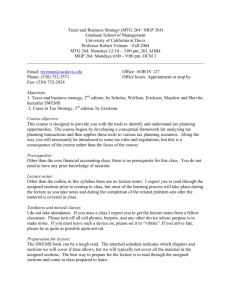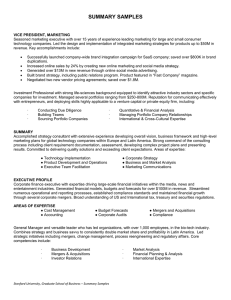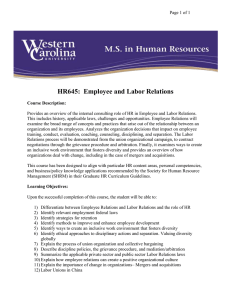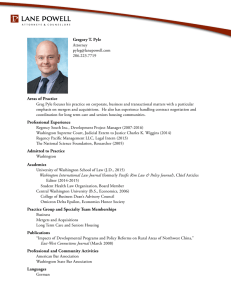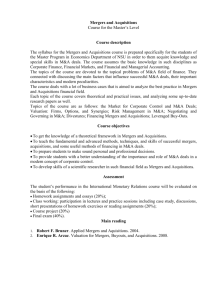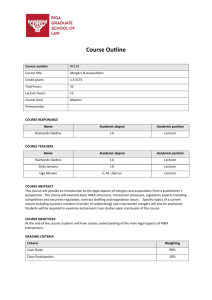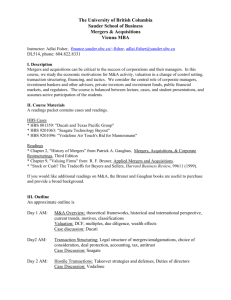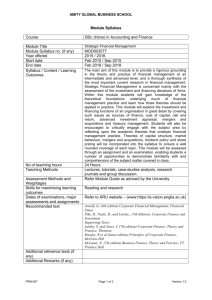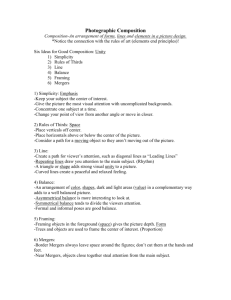Taxes and Business Strategy (MGT 264 / MGP 264) Graduate
advertisement
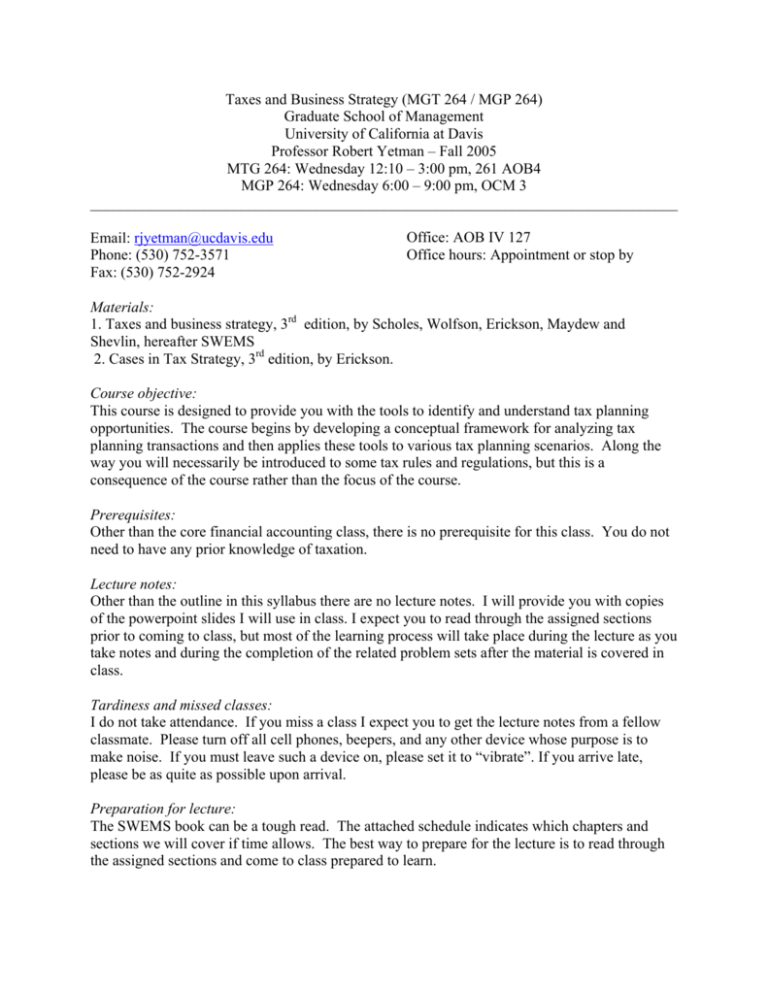
Taxes and Business Strategy (MGT 264 / MGP 264) Graduate School of Management University of California at Davis Professor Robert Yetman – Fall 2005 MTG 264: Wednesday 12:10 – 3:00 pm, 261 AOB4 MGP 264: Wednesday 6:00 – 9:00 pm, OCM 3 ______________________________________________________________________________ Email: rjyetman@ucdavis.edu Phone: (530) 752-3571 Fax: (530) 752-2924 Office: AOB IV 127 Office hours: Appointment or stop by Materials: 1. Taxes and business strategy, 3rd edition, by Scholes, Wolfson, Erickson, Maydew and Shevlin, hereafter SWEMS 2. Cases in Tax Strategy, 3rd edition, by Erickson. Course objective: This course is designed to provide you with the tools to identify and understand tax planning opportunities. The course begins by developing a conceptual framework for analyzing tax planning transactions and then applies these tools to various tax planning scenarios. Along the way you will necessarily be introduced to some tax rules and regulations, but this is a consequence of the course rather than the focus of the course. Prerequisites: Other than the core financial accounting class, there is no prerequisite for this class. You do not need to have any prior knowledge of taxation. Lecture notes: Other than the outline in this syllabus there are no lecture notes. I will provide you with copies of the powerpoint slides I will use in class. I expect you to read through the assigned sections prior to coming to class, but most of the learning process will take place during the lecture as you take notes and during the completion of the related problem sets after the material is covered in class. Tardiness and missed classes: I do not take attendance. If you miss a class I expect you to get the lecture notes from a fellow classmate. Please turn off all cell phones, beepers, and any other device whose purpose is to make noise. If you must leave such a device on, please set it to “vibrate”. If you arrive late, please be as quite as possible upon arrival. Preparation for lecture: The SWEMS book can be a tough read. The attached schedule indicates which chapters and sections we will cover if time allows. The best way to prepare for the lecture is to read through the assigned sections and come to class prepared to learn. Exams: There will be two exams. The first exam is a take home, open book, open notes (closed colleague) handed out at the end of the second class. The first exam will cover the tax planning framework that is covered in the first two weeks of the class. The first exam is due at the beginning of the third class, no exceptions. The second exam is an in-class final that is open book only (closed notes and closed colleague). The final exam will not cover the tax planning framework, but instead will cover the applications chapters covered in class. Only material covered in class will be included on the final exam. The format will be short answer/short problem. Homework sets: There will be several problem sets assigned as noted on the class schedule. The homework sets will not be picked up nor will they be graded. They are intended to help you to understand the material. Exam material for the final exam will draw heavily from these assigned homework problems. Case presentations: There will be 9 case presentations. You will be required to take part in presenting one case. You will self assign into 9 groups by next week’s class. Any person not assigned to a group will be randomly assigned by me. The number of people per group will be the class size divided by 9 (some groups will have 3 and others will have 4). The cases will highlight a tax planning strategy that your group will attempt to “sell” to the class. You must be prepared to respond to questions from the audience. Your grade will be based on how technically complete and correct your presentation is and how you answer my questions. The audience will be encouraged to ask questions about your case, but these questions will not affect your grade in any way (but they will affect the class participation grade of the questioner). You should assume that your audience knows little about the details of your tax planning strategy, but they do know exceedingly well the framework you learned in class. You will have only 25 minutes to present your case and respond to questions, so you need to be well polished and efficient with your time. You may use any presentation method you wish, but at a minimum you should have presentation slides prepared. Other than the presenting group, each of you will turn in a completed problem set for the case. The presenting group will be provided with answers to the case, but only after they attempt to work the case and give me the answers. Every member of a group must present some portion of the case. Grading: Take home exam: Problem sets for cases, 5 points each : Case presentation: Participation during cases: Final exam: 15% 45% 15% 10% 15% Taxes and Business Strategy (MTG 264 / PGP 264) Graduate School of Management University of California at Davis Professor Robert Yetman – Fall 2005 Tentative Course Schedule ______________________________________________________________________________ Week 1 October 5 Introduction, course outline, grading policies. Lecture – Tax strategy framework SWEMS chapter 2 sections 1 and 2 SWEMS chapter 3 sections 1, 2 and 3 Week 2 October 12 Lecture – Tax strategy framework SWEMS chapter 4 sections 1, 3, and 4 SWEMS chapter 5 all sections SWEMS chapter 6 section 5 Take-home exam handed out Week 3 October 19 Lecture – Compensation and retirement planning SWEMS chapter 8 sections 1, 2, and 5 SWEMS chapter 9 sections 1, 2, and 6 Case presentation due – None Take-home exam due at beginning of class Week 4 October 26 Lecture – Individual and estate tax planning SWEMS chapter 18 sections 1 through 5 Case 1 presentation due – Compensation and retirement planning: “Stock Options Gone Bad” Week 5 November 2 Lecture – Corporate tax planning SWEMS chapter 12 sections 2, 4, and 5 Case 2 presentation due – Individual and estate tax planning: “SC2 transactions” Case 3 presentation due – Individual and estate tax planning: “Estee Lauder, Monetizing appreciated assets without triggering taxation” Week 6 November 9 Lecture – Mergers and acquisitions tax planning SWEMS chapter 13 all sections SWEMS chapter 14 section 1 SWEMS chapter 16 sections 1 and 2 Case 4 presentation due – Corporate tax planning: “Analysis of the Tax and Financial Statement Effects of Enron’s use of Monthly Income Preferred Stock (MIPS)” Week 7 November 16 Lecture – Multinational tax planning SWEMS chapter 10 sections 1 and 3 SWEMS chapter 11 sections 1, 2, and 3 Case 5 presentation due – Mergers and acquisitions tax planning: “Analysis of the tax consequences of Worldcom’s acquisition of MCI” Week 8 November 23 No class the week of Thanksgiving Week 9 November 30 Lecture – Tax evasion Case 6 presentation due – Multinational tax planning: “Firm valuation effects of the expatriation of U.S. corporations to tax-haven countries”. Case 7 presentation due – Mergers and acquisitions tax planning: How to Save $1 Billion in Taxes: Seagram and DuPont” Week 10 December 7 Lecture – None Case 8 presentation due – Tax evasion: “Business purpose / Profit motive: Compaq’s purchase and sale of shell common stock” Case 9 presentation due – Corporate tax planning: “Contingent Liability Tax Shelters” Final Exam December 14
